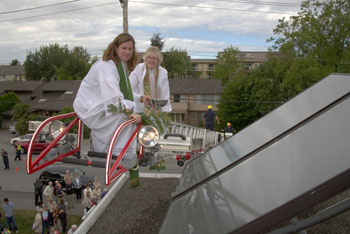Ever wondered how to start making your creaky, leaky, drafty church building more environmentally friendly?

Until May 31, Canadian Anglican congregations can apply for grants of up to $1,000 to subsidize a green building audit—a process that will help churches identify which areas of their buildings need to become more energy efficient.
St. Luke’s, Ottawa, is one of several churches that has already done an audit. In 2012, a group of parishioners spent a day examining their building with a professional green building auditor.
They found flaws to fix: an old, inefficient furnace; a room with hot appliances and cooling systems close together; and a front door so drafty that they call it the “loonie dispenser.”
Now St. Luke’s is investing in cost-saving improvements, leaving them with more money for mission.
“Greening” a building has many benefits, says Randal Goodfellow, chair of both General Synod’s Creation Matters national working group and the Diocese of Ottawa’s Creation Matters committee.
Many churches consider these audits as a step toward living out the fifth Mark of Mission, “to strive to safeguard the integrity of creation, and sustain and renew the life of the earth.”
(The Marks of Mission are used as a ministry framework throughout the Anglican Communion and are a priority for the Anglican Church of Canada.)
Some advocates even talk about these improvements as maximizing “mission per square foot,” said Mr. Goodfellow. The philosophy is to steward the space in the best possible way, considering heating, water use, cleaning products, and even whether pews are the best way to use sanctuary space.
Another benefit is building community.
“[The audit is] done with people from the congregation,” said Mr. Goodfellow. “They become internal champions and this starts or strengthens a green team in a parish.”
Though the application process and audit itself are not time-consuming, parishes must be committed to making change, said Mr. Goodfellow, who produced two videos with partners in the Diocese of Ottawa to promote the program.
“If it’s worth doing in the first place, it’s worth reporting to the congregation and worth undertaking the recommendations,” he said. “That’s when the work starts coming in.”
In exchange for the grant, parishes will host a public information seminar with Greening Sacred Spaces on energy efficiency. They must also provide energy consumption information to the Green Up Database of the Canada Green Building Council. This database will establish a baseline against which parishes can measure their performance, year over year.
The Green Building Audit grants are a result of resolution A180 on climate change, passed at General Synod 2010. A resolution coming to Joint Assembly 2013 will encourage dioceses to establish similar programs.
Grants are provided by General Synod’s Ministry Investment Fund and the audits are done in cooperation with Greening Sacred Spaces, a project of the interfaith coalition Faith and the Common Good.
Grants will cover two-thirds of the audit cost. The number awarded will depend on the number of applications received and the size of churches.
Across Canada there are already excellent examples and plans in place for Anglican churches to go green.
In Richmond, B.C., St. Alban Anglican Church has installed solar panels to offset their energy costs.
The West End Commons, a planned multi-use space built out of St. Matthew’s Anglican Church in Winnipeg, will use recycled building materials, upgraded eaves, and energy efficient appliances in its redesign.
- Learn more and apply for a green building audit grant (due May 31, 2013)
- Learn about the Green Building Audit (and the story of St. Luke’s) in a video produced by Diocese of Ottawa
- Learn about Creation Care in this video produced by the Diocese of Ottawa
- For more information, email Stephen Collette, Green Audit Coordinator, Faith and the Common Good, or call him at (705) 652-5159.
- Interested in getting involved with Creation Matters at General Synod? Email Henriette Thompson, General Synod’s public witness coordinator for social justice.
Interested in keeping up-to-date on news, opinion, events and resources from the Anglican Church of Canada? Sign up for our email alerts .
